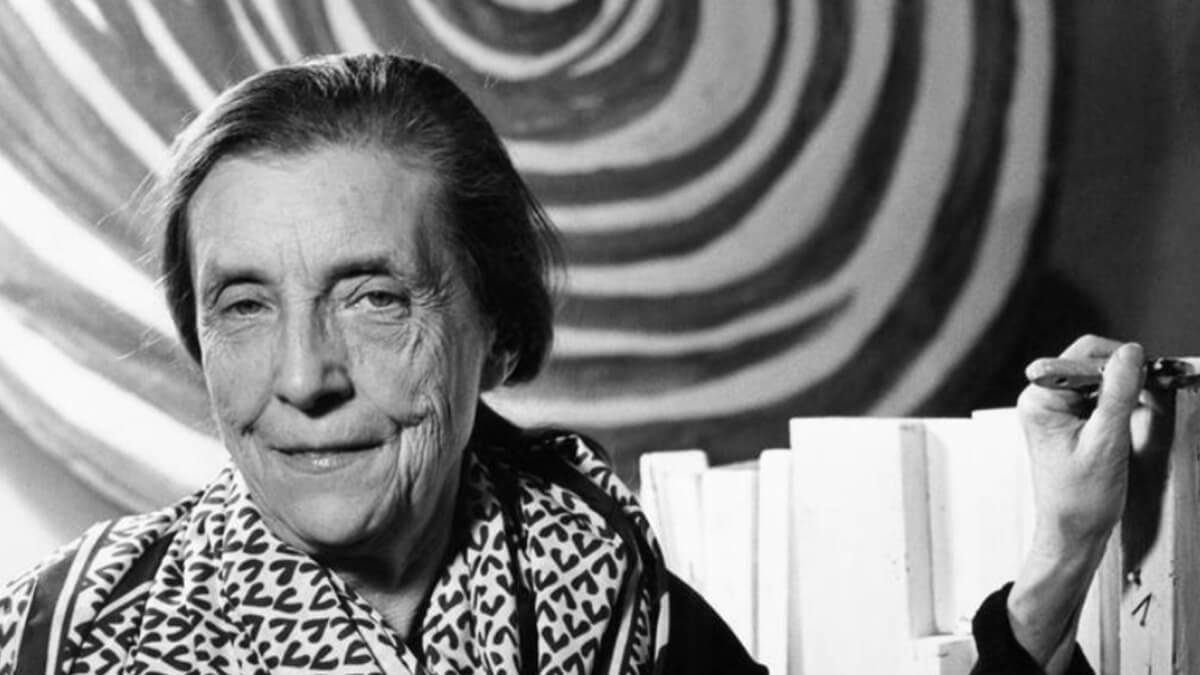
10 Things To Know About Frida Kahlo

Key dates in Frida Kahlo’s life
- 1907: She is born in Mexico
- 1913: She contracts polio aged 6
- 1922: She attends the prestigious National Preparatory School in Mexico City
- 1925: She is injured in a bus accident and begins painting
- 1929: She gets married to artist Diego Rivera
- 1939: She gets divorced and produces her famous painting The Two Fridas
- 1940: She remarries Rivera
- 1941: She produces the painting Me and My Parrots
- 1954: She dies
Frida Kahlo is one of the few female painters to be world-famous, while at the same time being one of the only artists in Mexico to be internationally known. The Mexican, the lame, the revolutionary, the non-conformist, the surrealist…so many adjectives to describe a woman who is above all free, singular both in her work and in her life. Frida’s life was far from easy. It has been brought to light many times through biographies and films. But do you really know her story? Artsper reveals 10 anecdotes from the life of this iconoclastic artist!
1. Frida Kahlo was Mexican and of Spanish descent

Magdalena Frida Carmen Kahlo Calderón, her full name, was born on July 6, 1907. Known as Frida Kahlo, the artist often falsified her birth date, setting it back to July 7, 1910, the year the Mexican Revolution began.
Kahlo was born in Mexico City. Her mother, Matilde Calderón y González, came from a family of Spanish generals, also with an Indian background. Her father, Carl Wilhelm Kahlo Kauffmann, was born in Germany. Contrary to what Frida claimed, he was not Jewish. Her family was Lutheran and belonged to the middle class of the Grand Duchy of Baden. When he arrived in Mexico in 1891, he took the name Guillermo Kahlo and settled as a photographer.
2. She didn’t have a happy childhood

Frida Kahlo was born after her mother lost a son. Depressed, her mother gave her to a nanny. She was a very cold woman.
The atmosphere at Frida Kahlo’s family home was particularly melancholy. Apart from tensions within the household between parents and two absent half-sisters living in a convent, her father’s business was not flourishing during the Mexican revolution.
Moreover, young Frida’s health was fragile. She was born with spina bifida, deforming her spine, and at the age of 6, she contracted polio. Because of this serious infectious disease, Frida suffered from chronic pain. In addition, her right leg stopped growing, causing a malformation. The disease also isolated Frida from other children. Nicknamed “Fria la coja”, meaning “Frida the lame,” she cannot go to school. Later, the first years of her schooling were tumultuous. She entered a German school according to her father’s wishes and was soon expelled for disobedience. This episode testifies to a strong and reckless character from an early age. She then enrolled in a vocational school for women teachers, where she also stayed for a short time. She was removed from the institution when her parents discovered that she had been sexually abused by one of the teachers.
3. Frida Kahlo almost became a doctor

Kahlo didn’t always aspire to be a painter. Certainly, from an early age, her father passed on his taste for fine art to her. A friend of her father’s, an engraver, even gave her a few drawing lessons. Also, she helped her father in his professional activity by retouching, developing, and coloring photographs. Nevertheless, she considered art more as a hobby.
At the age of 16, she was one of the first 35 girls to be accepted into the Escuela Nacional Preparatoria, out of a total of 2,000 students. It was the best school in Mexico at the time. There, she showed a strong interest in natural sciences and wanted to become doctor.
4. A bus-crash begins her career
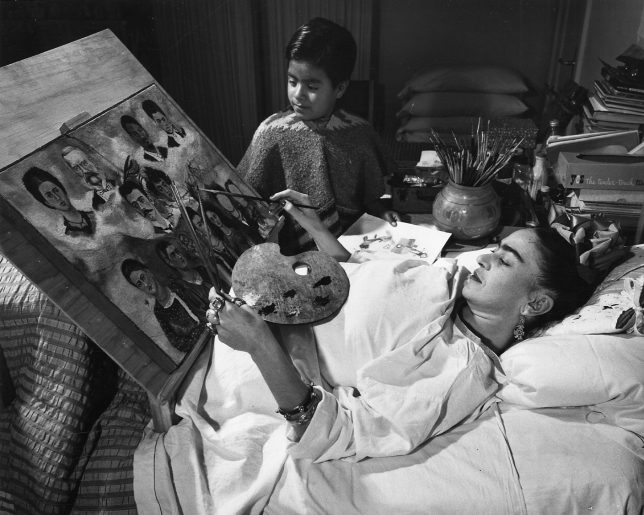
On 17 September 1925, on her way home from school, Frida’s bus hit a tramway. This accident sealed her fate. Although she survived, she was nevertheless seriously injured. Her pelvic cavity was pierced by a metal bar, which would cause systematic miscarriages. Frida also suffered 11 fractures to her right leg. Her right foot and her shoulder were completely dislocated. Her spine and femoral neck were broken. Suffering excruciatingly, Frida remained in bed for several months. In total, until the end of her life, she underwent 32 surgeries and wore 28 corsets.
Back home, Frida Kahlo was forced to stay in bed. The artist wrote at the time: “I am not dead and I have a reason to live. That reason is painting”. With her ability to move being compromised, Frida’s family encouraged her to paint. They made her a special easel and a canopy bed with a mirror on the ceiling. Art became the outlet for all of her suffering and the catalyst for her healing. She began an important series of self-portraits, which continued to be her favorite subject.
5. Member of the communist party, Frida is a pioneer figure of feminism
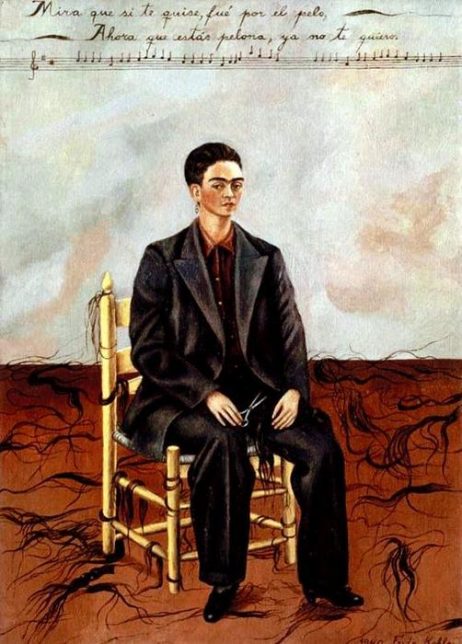
At the instigation of the photographer Tina Modotti, she joined the Mexican Communist Party in 1928. She was only 21 years old at the time and was just recovering from her accident.
Nevertheless, her commitment to the defense of social justice and the promotion of Mexican culture had emerged as a teenager. Indeed, the Escuela Nacional Preparatoria praised the indigenismo. This nationalist ideology emphasized Mexico’s indigenous heritage to assert the country’s superiority and reject the Western colonialist mentality. Thus, Frida Kahlo and nine other female comrades formed an informal group called “Cachuchas” (literally meaning “baseball caps”). Rejecting the conservative values of Mexico’s patriarchal and macho society, they discussed Russian politics and literature. Many of them became major figures of the Mexican intellectual elite.
Thus, within the Communist Party, in addition to class struggle, she was particularly committed to the emancipation and equality of women. She thus became a leading figure among feminist artists. Unsubmissive, protestant, and modern, she assumed her bisexuality at a time when few women dared to do so.
6. With Diego Rivera, Frida embodies one of the mythical couples in the history of art

The year 1928 was also marked by Frida’s decisive meeting with the muralist Diego Rivera. He was 20 years older and also a member of the Communist Party. Putting his art at the service of the people by creating large frescoes commissioned by the government, he was already very well-known. Frida and Diego’s common passions for painting and politics and their admiration for each other make them an ideal artist-couple.
Marrying in 1929, their relationship was both passionate and destructive. Frida confided: “I had two serious accidents in my life. One was caused by a bus, the other was Diego. Diego was by far the worst.” Indeed, Diego cheated on her several times… and she did the same in return. In 1935, Frida Kahlo saw her husband’s extramarital relationship with her sister as a real betrayal. Leaving their shared home for several months, their love remained unfailing. Frida also betrayed her marriage by having an affair with the communist revolutionary Leon Trotsky. In 1937, having been granted political asylum in Mexico, the Russian politician even stayed in their home. Divorced in 1938, they finally remarried in 1940, linked until their death.
The house in which they lived during their first marriage is symptomatic of their relationship. Consisting of two separate buildings, blue for Frida, white and pink for Diego, they are connected by a bridge. It is a metaphor for their relationship: separate but inescapably united.
7. Frida Kahlo is not a Surrealist painter
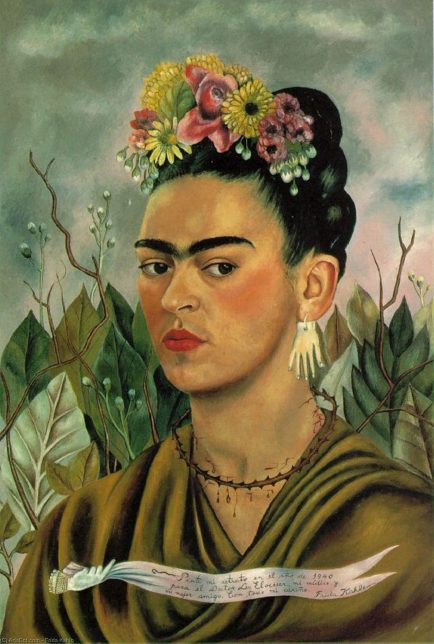
Traveling to Mexico City in 1938, the surrealist André Breton discovered the works of Frida Kahlo. Fascinated, he invited her to Paris in 1939 to take part in a major exhibition in Mexico.
However, both the city and the exhibition displeased Frida Kahlo. The event was, according to her, a “smokehouse”. It was far too caricatured and picturesque of her nation. In addition, not all of her paintings were retained and her paintings were misinterpreted. Frida stated: “It’s not fair. I never painted dreams. What I portrayed was my reality.” Indeed, for her, her paintings are, above all, autobiographical. Misunderstood, she rejects this group of scornful and pretentious intellectuals. On the subject of the Surrealists, she writes in a letter to Nickolas Murray: “I’d rather sit on the floor of the Toluca market selling tortillas than have anything to do with those lousy Parisian artists.”
Yet this visit to France heralds the beginning of Frida’s international recognition. Admired in the Parisian art world, Picasso gave her ivory earrings in the shape of hands, fashion designer Schiaparelli made her the Madame Rivera dress and the Louvre bought her a self-portrait.
8. Her works are the metaphorical biography of her life

Frida Kahlo’s work is inseparable from her life. From the very beginning of her artistic practice, immobilized after her accident, Frida Kahlo took her own image as her favorite subject. She depicts her moral and physical suffering without modesty or concession. Among the most famous, The Broken Column (1944) reveals her body bruised by a succession of surgical operations.
In all, nearly 70 self-portraits reflect her story. She portrays herself in retrospect, born then as a child, as in My Nurse and I (1937), and sometimes with her parents. She also portrays her relationship with her partner and discusses their miscarriages, as in the painting Henry Ford Hospital (1932).
But it is more her “Mexicanness” that she claims in the representations of herself. It reveals her deep affection for her nation’s cultural heritage. In fact, she often wears the China Poblano, a traditional dress, very colorful and embellished with floral embroidery. Frida also frequently wears braids or buns decorated with flowers. More generally, in many of her paintings, Mexican culture is symbolized, especially by its fauna and flora. Parrots and cacti are integrated into her compositions, as well as other elements of local folklore (flags, exquisite corpses and more).
Finally, her political commitment is also clearly reflected in several paintings. Frida’s Self-Portrait with Stalin (1954) or Marxism will restore Health to the Sick (1954) bear witness to this. At the end of her life, portraying herself as a deer pierced with arrows or beside corpses, many evocations of death are perceptible.
9. She lived in pain all her life and her last years were especially difficult
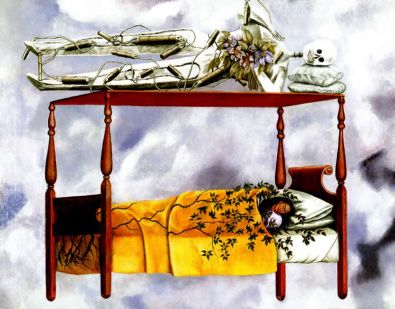
Behind her optimism and unfailing joyfulness, Frida Kahlo suffered constant pain from her back to her feet. Her state of health deteriorated particularly from 1950 onwards. She underwent 7 operations on her spine. While her first monographic exhibition was held in 1953, her doctor forbade her to leave her bed. She then asked that her bed be moved to the gallery where she made a triumphant entrance, like a queen on her throne.
Shortly afterward, developing gangrene following one of her surgeries, she had her right leg amputated. This event caused her to sink into a deep depression. Finally, in 1954, suffering from pneumonia, she died a few days after her 47th birthday. Shortly before she died, she wrote: “I hope it will be a joyful exit and I hope I never come back. Waiting to die with open arms, the hypothesis of suicide is not totally excluded…”
According to her wishes, Frida Kahlo was cremated. She didn’t want to be buried lying down, having suffered too much from that position.
10. Frida Kahlo received national recognition during her lifetime
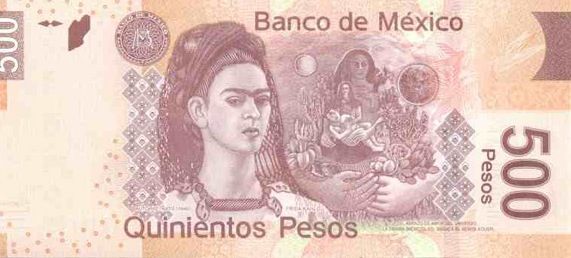
Living for a long time in the shadow of her husband, in 1942, her election to the Seminario de Cultura Mexicana testifies to her recognition by public institutions. The Seminario de Cultura Mexicana is a group of well-known personalities from the cultural world, created by the government to promote Mexican culture through exhibitions, conferences, and publications.
Subsequently, in 1943, the School of Fine Arts entrusted her with the teaching of painting in one of its classes. In 2010, for the creation of a new 500 peso banknote, the Mexican Federal Bank chose to decorate one side with her portrait and the other with that of Diego Rivera. Not only an icon in the history of art, but it also became policy in the 1990s for the Chicano movement, a movement fighting for the civil rights of Mexican-Americans.
Remembering Frida Kahlo…
To conclude, more than being an artist, Frida Kahlo is a symbol. A symbol of Mexico, and she is especially a symbol for women. Her strength of character and independence make her an emblem for the feminist and LGBTQ+ movements. Having inspired many artists, her figure has also been re-exploited commercially. Printed on posters, mugs, T-shirts, and other merchandise, she has, despite herself, become an icon of pop culture and street art. Without a doubt, the anti-capitalist that she was must be turning over in her grave by witnessing the misappropriation of her work and her image! But she would surely be reassured to see that her artistic and political influence has not waned.
Key Kahlo exhibitions
- 1938: First solo exhibition at Julien Levy Gallery, New York
- 1939: Kahlo travels to Paris to show her work
- 1940: International Exhibition of Surrealism at the Galeria de Arte, Mexico
- 1953: First solo exhibition in Mexico
- 1958: The Museo Frida Kahlo (The Frida Kahlo Museum) is founded in Mexico City
- 1978: First two retrospectives of Kahlo’s work at the Palacio de Bellas Artes, Mexico City, and the Museum of Contemporary Art, Chicago

About Artsper
Founded in 2013, Artsper is an online marketplace for contemporary art. Partnering with 1,800 professional art galleries around the world, it makes discovering and acquiring art accessible to all.
Learn more












